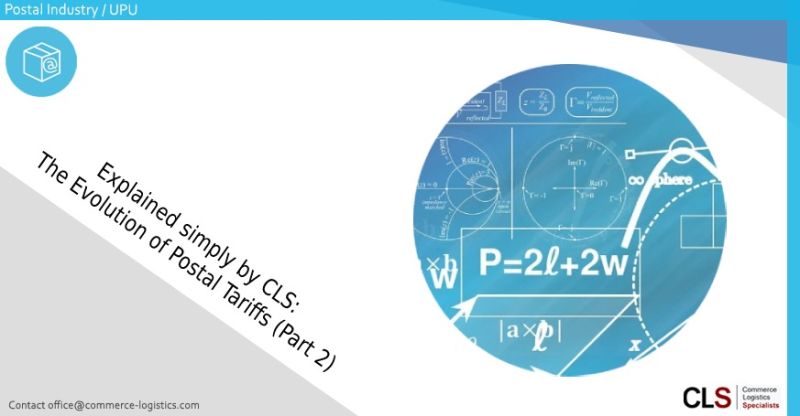Explained simply by CLS: The Evolution of Postal Tariffs (part 2)

𝗘𝘅𝗽𝗹𝗮𝗶𝗻𝗲𝗱 𝘀𝗶𝗺𝗽𝗹𝘆 𝗯𝘆 𝗖𝗟𝗦: 𝗧𝗵𝗲 𝗘𝘃𝗼𝗹𝘂𝘁𝗶𝗼𝗻 𝗼𝗳 𝗣𝗼𝘀𝘁𝗮𝗹 𝗧𝗮𝗿𝗶𝗳𝗳𝘀 (𝗽𝗮𝗿𝘁 𝟮)
In July 1971, the #UPU adopted a #system in which the sending #country pays the receiving country for #handling, #delivering and (if required) #customsclearance of #international mail (“Terminal Dues” (#TD). These TD rates could be applied when mail followed UPU #standards, #forms and #codes, and the #flow between designated postal operators (#DO) used specific, clearly defined post offices (Offices of Exchange).
Originally created for the #exchange of letter #mail (“letters containing matters of #correspondence”), the system evolved with the rise of #commercialitems (“letters containing goods or merchandize”), becoming the dominant #tariff #model for developing cross-border #ecommerce.
𝗦𝘁𝗮𝗿𝘁𝗶𝗻𝗴 𝗽𝗼𝗶𝗻𝘁: 𝗞𝗶𝗹𝗼 𝗿𝗮𝘁𝗲𝘀
In its first 30 years from 1971 to 2000, TD consisted of a #fixedrate per kilogramme and applied to all DOs. Naturally, this model failed to account for the different #cost structures in the destination countries, and the fact that delivering ten 100g items generates a different level of costs than a single 1kg item.
𝗡𝗲𝘅𝘁 𝘀𝘁𝗲𝗽: 𝗶𝘁𝗲𝗺/𝗸𝗶𝗹𝗼 𝗿𝗮𝘁𝗲𝘀 𝗿𝗲𝗳𝗲𝗿𝗲𝗻𝗰𝗲𝗱 𝘁𝗼 𝗱𝗼𝗺𝗲𝘀𝘁𝗶𝗰 𝘁𝗮𝗿𝗶𝗳𝗳𝘀
In 1999 the UPU decided to introduce a per-item and per-kilogramme rate for #postalitems.
-The rates were set annually by the UPU. They were calculated according to a complex model which referenced domestic #tariffs.
-Part of the remuneration was linked to the Quality of Service (lead-time; % of items delivered within J+5 or J+3).
-Each country was assigned to one of four groups (1 to 4). A country’s level of #payment to the respective destination country for #delivery depended on its own #developmentstatus.
-The #rates were set in #SDR (“Special Drawing Rights”), an international #reserve asset, created and managed by the #IMF.
-Both rates and SDR exchange rates were fixed in advance and remained valid for one year.
However, this model was still problematic from the viewpoint of the #importing countries. As a result of the item/kilo model, lightweight import #shipments, in particular, became considerably cheaper for the #sender than the corresponding #domesticshipments, as #domestic rates usually assigned a fixed #price within a weight interval and within specific dimensions. In addition, the world’s largest and most developed ecommerce #exportmarket, #China, was still able to use #tariff discounts based on its historical #status as a #developingcountry.
Consequently, the model needed to be adjusted once more.
To be continued.
Hier geht es zum LinkedIn-Artikel.

Walter Trezek
Document Exchange Network GmbH

